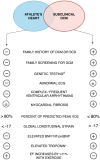Dilated cardiomyopathy in the era of precision medicine: latest concepts and developments
- PMID: 34263412
- PMCID: PMC8279384
- DOI: 10.1007/s10741-021-10139-0
Dilated cardiomyopathy in the era of precision medicine: latest concepts and developments
Abstract
Dilated cardiomyopathy (DCM) is an umbrella term entailing a wide variety of genetic and non-genetic etiologies, leading to left ventricular systolic dysfunction and dilatation, not explained by abnormal loading conditions or coronary artery disease. The clinical presentation can vary from asymptomatic to heart failure symptoms or sudden cardiac death (SCD) even in previously asymptomatic individuals. In the last 2 decades, there has been striking progress in the understanding of the complex genetic basis of DCM, with the discovery of additional genes and genotype-phenotype correlation studies. Rigorous clinical work-up of DCM patients, meticulous family screening, and the implementation of advanced imaging techniques pave the way for a more efficient and earlier diagnosis as well as more precise indications for implantable cardioverter defibrillator implantation and prevention of SCD. In the era of precision medicine, genotype-directed therapies have started to emerge. In this review, we focus on updates of the genetic background of DCM, characteristic phenotypes caused by recently described pathogenic variants, specific indications for prevention of SCD in those individuals and genotype-directed treatments under development. Finally, the latest developments in distinguishing athletic heart syndrome from subclinical DCM are described.
Keywords: ARVC; Athletic heart syndrome; BAG3; Cardiomyopathies; DCM; DSP; Dilated cardiomyopathy; FLNC; Heart failure; Hypokinetic non-dilated cardiomyopathy; Inherited cardiac diseases; LMNA; Molecular cardiology; PLN; Precision medicine; TMEM43.
© 2021. The Author(s), under exclusive licence to Springer Science+Business Media, LLC, part of Springer Nature.
Conflict of interest statement
The authors declare no competing interests.
Figures



References
-
- Pinto YM, Elliott PM, Arbustini E, et al. Proposal for a revised definition of dilated cardiomyopathy, hypokinetic non-dilated cardiomyopathy, and its implications for clinical practice: a position statement of the ESC Working Group on Myocardial and Pericardial Diseases. Eur Heart J. 2016;37(23):1850–1858. doi: 10.1093/eurheartj/ehv727. - DOI - PubMed
Publication types
MeSH terms
LinkOut - more resources
Full Text Sources
Miscellaneous

